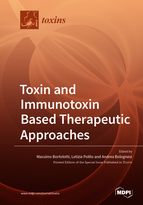Toxin and Immunotoxin Based Therapeutic Approaches
A special issue of Toxins (ISSN 2072-6651).
Deadline for manuscript submissions: closed (30 September 2021) | Viewed by 29063
Special Issue Editors
Interests: cell death; immunoconjugates; immunotherapy; immunotoxins; lectins; oxidative stress; plant toxins; ribosome-inactivating proteins; ricin; xanthine oxidoreductase
Interests: cancer therapy; drug delivery; immunoconjugates; immune targeting; plant toxins
Special Issues, Collections and Topics in MDPI journals
Interests: Xanthine oxidoreductase; oxidative stress; uric acid; nitric oxide; cytotoxicity; plant toxin; rRNA glycosylase; immunotoxin; targeted therapy; anti-tumour therapy
Special Issues, Collections and Topics in MDPI journals
Special Issue Information
Dear Colleagues,
In 1900, Paul Ehrlich, who was studying ricin and abrin at the time, discovered antibodies and paved the way to immunotherapy. After 120 years, Ehrlich’s insight into the therapeutic potential of immunotargeting is still a source of inspiration for many scientists. One of the most studied antibody-based targeting strategies is the carrying of powerful toxins. The generated molecules are immunotoxins, chimeric proteins obtained by coupling bacterial or plant toxins and antibodies through chemical linking or genetic engineering. Immunotoxins are functionally designed to eliminate the cells responsible for pathological conditions, and they find applications in several fields, ranging from cancer to immunological diseases or pain control. Despite the lack of specificity, even native toxins find clinical application, but the use of unconjugated toxin is limited to loco-regional treatments.
A fundamental requirement for the medical application of toxins and their immunoconjugates is in-depth knowledge of their interaction with target cells in terms of binding, uptake, intracellular routing, and substrate specificity.
This Special Issue focuses on toxins and immunotoxins having clinical potential. We hope to give the reader a comprehensive overview of new toxin delivery strategies and toxin-based experimental disease models, both in vitro and in vivo.
Dr. Massimo Bortolotti
Dr. Letizia Polito
Prof. Andrea Bolognesi
Guest Editors
Manuscript Submission Information
Manuscripts should be submitted online at www.mdpi.com by registering and logging in to this website. Once you are registered, click here to go to the submission form. Manuscripts can be submitted until the deadline. All submissions that pass pre-check are peer-reviewed. Accepted papers will be published continuously in the journal (as soon as accepted) and will be listed together on the special issue website. Research articles, review articles as well as short communications are invited. For planned papers, a title and short abstract (about 100 words) can be sent to the Editorial Office for announcement on this website.
Submitted manuscripts should not have been published previously, nor be under consideration for publication elsewhere (except conference proceedings papers). All manuscripts are thoroughly refereed through a double-blind peer-review process. A guide for authors and other relevant information for submission of manuscripts is available on the Instructions for Authors page. Toxins is an international peer-reviewed open access monthly journal published by MDPI.
Please visit the Instructions for Authors page before submitting a manuscript. The Article Processing Charge (APC) for publication in this open access journal is 2700 CHF (Swiss Francs). Submitted papers should be well formatted and use good English. Authors may use MDPI's English editing service prior to publication or during author revisions.
Keywords
- antibody
- bacterial toxins
- cancer therapy
- drug delivery
- death mechanisms
- immunotoxins
- immunotherapy
- nanodelivery
- plant toxins
- ribosome inactivating proteins









